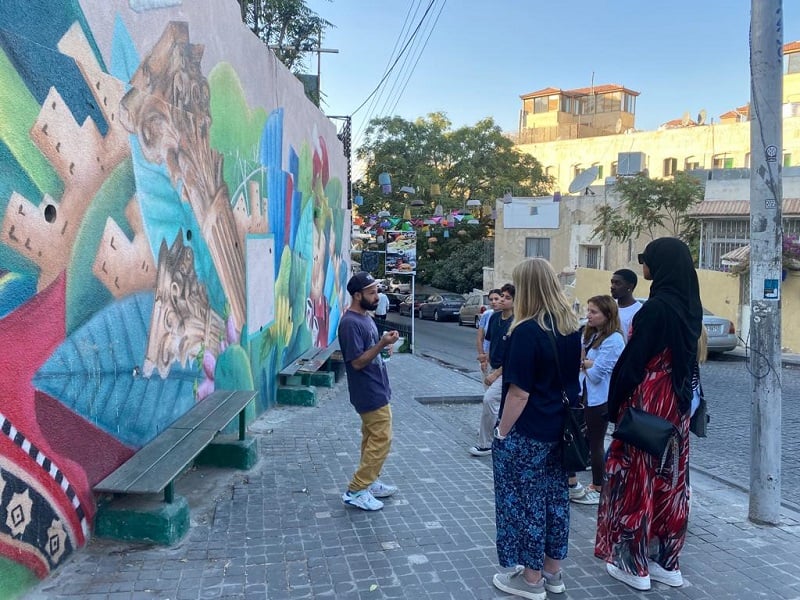Written by Madeleine Shaw, (Dartmouth College), Student Correspondent for CET Jordan, Fall 2023
Flashcards are forbidden here in Jordan. Instead of word-to-word memorization, our teachers emphasize learning from ideas and contextualizing new vocabulary using the local setting. In class, we accumulated new vocabulary by discussing famous figures such as Ghassan Kanafani, Mahmoud Darwish, and the Jordanian Royal Family. A welcome change from the emphasis on vocab-list memorization all too common in American foreign language courses, our homework typically revolves around interviewing taxi drivers and café employees or talking to our Jordanian neighbors. We’ve learned about religious practices through visits to churches and mosques, gained knowledge of cultural customs and local traditions such as Jordanian weddings and holiday celebrations, and even cooked Jordanian food for our classmates using Arabic-language recipes. One thing is clear: studying Arabic here in Jordan is definitely very different than at home.

CET took all of us students on a field trip to the Abdul Hameed Shoman Library, one of Amman’s only public libraries open to all who need a quiet place to study, work, or check out books. During our trip we were required to talk to library employees and visitors about Jordan’s study and work culture as well as their usually habits at the library (in Arabic, of course!). In interviewing library-goers, we happened to stumble across two social media influencers who were very curious about our study abroad experience, pictured above.
Various field excursions have also helped my classmates and I improve our language skills outside the classroom. On several occasions, CET has taken us to libraries and cafes to observe the local study culture and talk with employees and visitors about their experiences working in Jordan. Of course, not all of our program visits are strictly academic; our program recently went on a graffiti tour of downtown Amman, where a professional hip-hop dancer and graffiti artist gave us an interesting tour of Amman’s underground art culture.

Pictured here is Alaeddin, a hip-hop star and graffiti artist, giving my classmates and I an interesting tour of downtown Amman’s graffiti. The lovely weather and picturesque art combined with the interesting history of Amman’s underground graffiti culture made for a memorable evening in Jordan.
CET even hired a professional dance instructor to teach us how to dance ‘dabke’, a traditional Levantine dance usually performed at weddings or holiday celebrations. Out of all of our trips, my favorite thus far has been my class’s visit to my professor’s family home, where we were offered a taste of Jordanian hospitality, including rounds of tea and coffee as well as plenty of sweet treats. We practiced our vocabulary and improved our conversational skills while eating delicious homemade dishes and getting to know our generous hosts.
In addition to studying the Jordanian Arabic dialect and Modern Standard Arabic here in Jordan, students are also encouraged to take electives in their areas of interest. One of the additional classes I’ve been fortunate enough to take here is a class on refugees, forced migration, and integration (or lack thereof) in Jordan. Having interned at an American refugee agency in the past, the chance to learn about regional history, current political dynamics, and support organizations for refugees from a Jordanian perspective has filled meaningful gaps in my knowledge of the topic. The opportunity to talk with refugees and their descendants as well as organizations such as the UN Refugee Agency (UNHCR) has been an especially invaluable component of my time here in Amman, especially relevant given Jordan’s role as one of the top refugee-hosting nations in the world.

My friends and I found a beautiful local café called Kawon’s Kitchen in Madaba, about a thirty-minute drive from Amman. The beautiful spot had a bounty of books and cute cats as well as delicious homemade food and tea — all one could need for a productive day.
After five weeks of intensive Arabic classes, my CET classmates and I also began taking content courses in Arabic. For the past few weeks, I’ve been taking my first-ever content course entirely in Arabic on the history of conflict in the Middle East. Wary at first of the challenge of learning about history and politics in a foreign language, I’m fortunate to have an incredibly understanding teacher who helps my classmates and I accumulate relevant vocabulary and learn about critical moments in the region’s history through a Jordanian lens. Given the current conflicts raging in Jordan’s neighborhood, there has never been a more important time to be studying the influential historical events that continue to shape the day-to-day lives of so many in Jordan and beyond. Taking the topics we study in class outside of our CET center, I’m proud to be able to converse with my language partner and Jordanian neighbors about ongoing political events, a linguistic achievement I wouldn’t have dreamed of when I first arrived in Amman.
One of my favorite aspects of Jordanian culture is the endless prevalence of cafes. Nearly every city block you walk on, you will find one, if not two, cafes. Not all are the same; some coffee houses are for social gatherings and smoking hookah; others are quieter and mostly for studying; others still are a mixture of the two. Without fail, you can almost always find me at a café after class learning about a new cultural icon or historical event, sipping a latte, and listening to my favorite Arabic music.

A view of one of my favorite cafes as I sit here writing this blog post! The short walk to Sweifieh Village, a lively outdoor shopping center filled with picturesque restaurants and cafes, has become part of my daily routine in Amman.